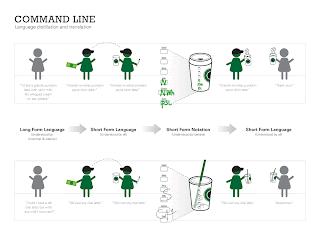Lean techniques are intended to reduce time to deliver
products to the customer, decrease costs, reduce waste while ensuring that the
value and customer experience is not compromised. Restaurants are challenged to
deliver hot and fresh food to customers, reduce wastes, manage costs by
controlling the purchase of raw material, etc. For example, Subway implements
lean techniques to produce the perfect sandwich for customers based on their
requirements. They do this by ensuring that all the bread is kept ready to go
in a baking case, vegetables are cut beforehand, the dressings are kept
together towards the end of the line near the cashier, thus ensuring sandwiches
are made in a fast, efficient manner. The value proposition Subway offers to
customers is fast and fresh sandwiches based on customers needs, thus
perfecting lean in the fast food chain.
In this post, I have decided to explore the lean techniques
that Starbucks is trying to implement. Wall Street Journal covered an article
on the same topic in 2009[1]. The challenges for Starbucks with handling lean are
different from that of a fast food chain. Lean processes are known to make
process robotic in nature. However, getting coffee at Starbucks is an
experience that needs to be handled with care. Starbucks employees are
encouraged to engage in conversations with customers while taking their order,
while at the same time ensuring that customers don't have to wait in lines for
very long. The idea was to increase the number of drinks each Starbucks
employees can make in an efficient manner, thus reducing the number of store employees
leading to cost savings for the company. The article highlights how 24% of the
annual revenue for the company is in store labor and there was room for
improvement to lower that number. Scott Hayden, the VP of lean thinking said "Motion and work are two different things. Thirty percent of the partners' time is motion; the walking, reaching, bending". The following techniques were employed at a
Starbucks location resulting in the reducing the time to make coffee from more
than a minute to 16 seconds.
1. Moving items closer reduced the movements behind the
counter
2. Altering the order of assembly of the coffee also helped.
3. Commonly used syrups were stacked away in an easily
reachable location
4. Whipped cream, chocolate, caramel drizzle where moved
closer to the delivery area since it was the last step before serving up the
coffee
Starbucks apparently offers over 80,000 different
combinations of drinks[2]. I would think it is impossible to remember every unique
combination for the Starbucks employee while making multiple drinks at the same
time. Starbucks, however, has a universal code to keep track of the drink
specifications. The coffee cups are designed in such a way that allows the
cashier to understand and communicate every minute detail of your drink to the
Starbucks employee preparing your coffee. As highlighted in the picture below,
acronyms help Starbucks employees prepare the right drink and even announce the
kind of drink while serving it up to the customer. This helps in making the customer
feel special because Starbucks has not only managed to concoct your favorite
drink, but is also able to repeat your highly customized order. This is a
significant process improvement as opposed to writing down orders in a paper
and having to check back regularly to ensure it is the right combination being
asked for.
The next time you walk into a Starbucks, be mindful of the
process being followed by the employees to prepare your coffee. The value
proposition of Starbucks is to ensure that customers get their order in a timely manner while being polite and serving up a hot cup of coffee as and when they ask for
it. Take some time to think about how Starbucks can further improve its
process.
[1]: Latest Starbucks Buzzword: 'Lean' Japanese Techniques. http://online.wsj.com/article/SB124933474023402611.html
[2]: Starbucks Stays Mum on Drink Math

No comments:
Post a Comment
Note: Only a member of this blog may post a comment.